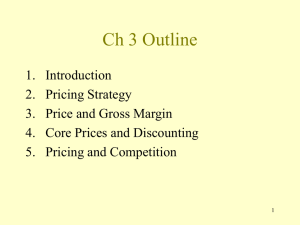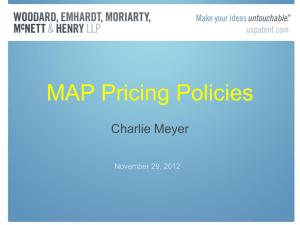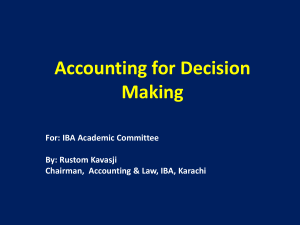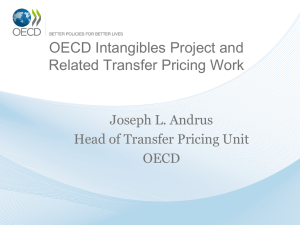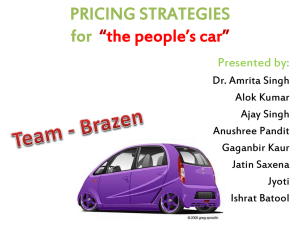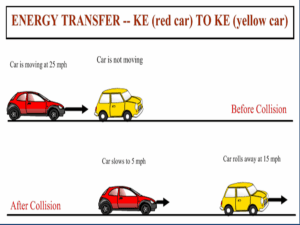Froeb_12 - Vanderbilt Business School
advertisement
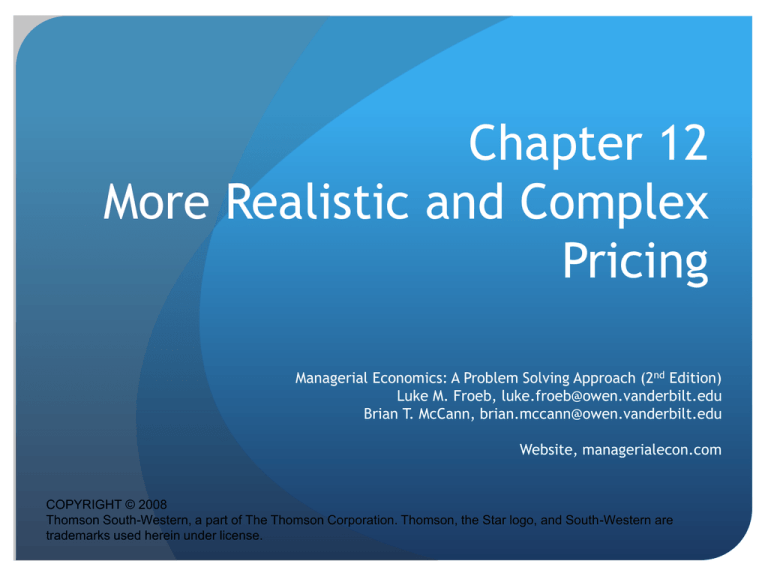
Chapter 12 More Realistic and Complex Pricing Managerial Economics: A Problem Solving Approach (2nd Edition) Luke M. Froeb, luke.froeb@owen.vanderbilt.edu Brian T. McCann, brian.mccann@owen.vanderbilt.edu Website, managerialecon.com COPYRIGHT © 2008 Thomson South-Western, a part of The Thomson Corporation. Thomson, the Star logo, and South-Western are trademarks used herein under license. Summary of main points • After acquiring a substitute product, • raise price on both products to eliminate price competition between them. • raise price more on the low-margin (more price elastic demand) product. • reposition the products so that there is less substitutability between them. • After acquiring a complementary product, reduce price on both products to increase demand for both products. • If fixed costs are large relative to marginal costs, capacity is fixed, and MR > MC at capacity, then set price to fill available capacity. Summary of main points (cont.) • If demand is unknown, and the costs of underpricing are smaller than the costs of over-pricing, then underprice, on average, and vice-versa. • If promotional expenditures make demand more elastic, then reduce price when you promote the product, and vice-versa. • Psychological biases suggests “framing” price changes as gains rather than as losses. Introductory anecdote: Harry Potter • When Scholastic Publishing released the final Harry Potter, sales expectations were through the roof – the previous HP had sold over 7M copies in the first 24 hours alone. • Scholastics suggested selling price was $34.99, and they sold the book to wholesale retailers for $18.99 • Instead of following the advice in chapter six and pricing the book at the point where the markup equals the inverse demand elasticity (P-MC)/P = 1/|e|, Barnes and Noble, Amazon, Costco, and Walmart all priced the book at less than $20 • These retailers are clearly interested in maximizing profit, so why were prices so low? • In this chapter, we move beyond the simple, single-product analysis of Chapter 6 to more realistic settings. In fact, the MR=MC pricing rule applies only to a single-product firm setting a single price. For firms that sell multiple products, or those who use low prices to win new customers, the rule does not hold. Pricing schemes • We have seen this kind of pricing before, the low price for 3-liter Coke used merely to attract customers to a grocery store. Whatever the grocery store lost on 3-liter Cokes, it made up in sales on other items. • Amazon was following a similar tactic. By pricing low, Amazon sold over two million copies of HP. • Some were new customers, who would purchase books from Amazon in the future; and some purchased additional items at the same time they purchased The Deathly Hallows. • In fact, Amazon estimates that about 1% of its $2.89 billion second-quarter revenue was due to added sales from customers who also purchased The Deathly Hallows. • Both the grocery store and the bookstore were pricing where MR < MC, or equivalently where (P-MC)/P < 1/|e|. They did so because they were trying to maximize total profit, not profit on their individual product lines. Pricing commonly owned substitutes • To price commonly owned products, use marginal analysis • Discussion: Purchasing a nearby, rival video store • How does this change the price of video rentals at each store? • If there were only one store, marginal analysis finds the point where MR=MC to maximize profits, BUT common ownership of two substitutes changes the calculation • Reducing price at one store steals sales from the other (reduces MR at both) • To counter the falling MR, raise prices at both stores to maximize profits • Consider your product portfolio as a “bundle” of goods • Demand for a bundle of substitutes is less elastic than demand for the individual products - less elastic demand implies a higher optimal price • Raise the price more on the more elastic product (try to push pricesensitive customers to the higher-margin product) Another option for substitutes • After acquiring a substitute product, you can reposition the products so they don’t directly compete with each other. • For example, you might want to stock multiple copies of the most popular videos at one of the stores (add depth) but stock a wider range of titles (add breadth) at the other. • Moving the products farther apart can further increase profit after acquiring a substitute product. Pricing commonly owned complements • Again, use marginal analysis to determine pricing. • Discussion: Purchasing a parking lot adjacent to video store • Common ownership means pricing decisions must consider the effects on movie rentals as well as parking lot use. • Reducing price at one increases demand at the other, i.e., common ownership increases MR at both • With bigger MR, reduce price (sell more) to maximize profits • Again, consider your product portfolio as a “bundle” of goods • Demand for a bundle of complements is more elastic than demand for the individual products • More elastic demand implies a lower optimal price Revenue or yield management • Products such as cruise ships, hotels, stadiums, commercial parking lots, etc. have similar characteristics. • The costs of building capacity are mostly fixed or sunk • And, these businesses face capacity constraints • The first decision for these firms is how much capacity to build – because this is an extent decision, marginal analysis can be used. • Keep adding capacity until LRMR = LRMC • Once capacity is built, firms make pricing decisions, ignoring the sunk or fixed costs of building capacity. • Relevant costs are now short-run MR and MC • If MR>MC at capacity, price to fill available capacity – because the capacity is fixed the firm cannot sell more by reducing price. Revenue management example • Example: designing a new hotel • keep adding rooms to the design plan, as long as LRMR > LRMC • Suppose that the optimal size is 300 rooms. At the optimal size, annualized LRMC of building, cleaning, and heating the room is about $400 per day. • Once the rooms are built/the costs have been sunk, the hotel’s owners must decide what to charge for the rooms. Suppose that 90% of the annualized LRMC are fixed or sunk and that the relevant marginal cost is just $40 per day. • Since capacity decisions are determined by all costs, and the pricing decision only by short-run MC, it ’s likely that MR > MC at the capacity of the hotel. If so, then the hotel’s owner should price to fill capacity (sell all available rooms). • Choose a price that matches expected demand to capacity • In some industries, like parking lots, stable demand and the daily observation of realized demand make this relatively easy to do • In other industries, like cruise ships, this is much more difficult Revenue or yield management (cont.) • When demand is difficult to predict, pricing to fill capacity is also difficult. • To maximize profits, balance the cost of over-pricing (lost profit on unsold capacity) against the cost of under-pricing (lower margins on capacity sold) • Optimal price minimizes the expected costs of these two mistakes. • In general, if the lost profit from over-pricing (unused capacity) is bigger than the lost profit from underpricing (lower margins), then price lower than would fill capacity, and vice-versa. Advertising and promotional pricing • Combines two of the “Four P’s of marketing,” Pricing and Promotion • Promotional spending affects demand in different ways • Price-related promotions (coupons, end-of-aisle displays, etc.) tend to make demand more elastic • If promotion makes demand more elastic, it makes sense to reduce price concurrently • Product-related promotions (quality advertising, celebrity endorsements, etc.) tend to make demand less elastic • If promotions make demand less elastic, it makes sense to raise price concurrently • Caveat: Prices can affect customer perception of quality – i.e. higher price equals higher quality in the mind of the consumer Psychological Pricing • Biases can affect optimal pricing decisions. • Example: Airline snacks • In 2008, some airlines began charging for snacks • It seems like a good idea because those who value an inflight snack could buy one and those who didn’t didn’t have to buy. • Many passengers, though, viewed the change negatively and changed airlines as a result. • Research in the field of behavioral economics says that this reaction was predictable using “prospect theory” • The way a decision is framed matters a great deal to the decisions that consumers make, i.e. consumers feel losses more than gains – so decisions should be framed in such a way to highlight a gain not the loss of an in-flight snacks. Psychological pricing (cont.) • Consumers are also very sensitive to fairness. • Many retailers make deliberate pricing decisions so as not to appear unfair • Home Depot didn’t raise prices after Katrina, though demand did increase; hardware stores don’t increase the price on snow shovels following a big winter blizzard • In 2008, when gas prices rose to meet consumer demand, many US citizens were outraged and heavily criticized oil companies for profiting “unfairly.” • To avoid looking unfair, companies must come up with creative solutions. • In the music industry, performers set concert ticket prices below the market price. People buy up the low priced tickets and sell them on secondary markets, which consumers don’t subject to rules of fairness. • Often, artists also sell tickets on secondary sites, sharing in the profits but avoiding the label of “unfair” Alternate intro anecdote • American Airlines pioneered the development of sophisticated reservation management systems, launching SABRE in 1968 • Without overbooking practices like those instituted through SABRE, AA estimates that 15% of the seats on sold out flights would be unused. • This overbooking process was the first element in developing a “yield management” system. • With additional industry changes in the 1970’s, AA moved to develop a yield management system with the goal of "selling the right seat to the right customer at the right time." Alternate intro anecdote (cont.) • The yield management system helps determine • How many seats to allocate initially to each fare category • How to dynamically adjust this allocation as reservations come in and the date of the flight approaches. • Accurate forecast of demand and cancellations are critical • The complexity of the problem eventually led to the development in 1988 of an automated system for yield management, DINAMO. The system's net impact was estimated be $1.4 billion in additional revenues over a three year period. Another pricing anecdote • Las Vegas Casinos • Offer both hotel rooms and gaming • Prices on rooms are often set at “sub-optimal” levels • Casinos plan to more than make up for the room profit shortfall with gaming profits • Similar to grocery store loss leader concept • Get people in the door • Goal is to maximize total profit, not individual product profit 18 1. Introduction: What this book is about Managerial Economics 2. The one lesson of business 3. Benefits, costs and decisions Table of contents 4. Extent (how much) decisions 5. Investment decisions: Look ahead and reason back 6. Simple pricing 7. Economies of scale and scope 8. Understanding markets and industry changes 9. Relationships between industries: The forces moving us towards long-run equilibrium 10. Strategy, the quest to slow profit erosion 11. Using supply and demand: Trade, bubbles, market making 12. More realistic and complex pricing 13. Direct price discrimination 14. Indirect price discrimination 15. Strategic games 16. Bargaining 17. Making decisions with uncertainty 18. Auctions 19. The problem of adverse selection 20. The problem of moral hazard 21. Getting employees to work in the best interests of the firm 22. Getting divisions to work in the best interests of the firm 23. Managing vertical relationships 24. You be the consultant EPILOG: Can those who teach, do?




